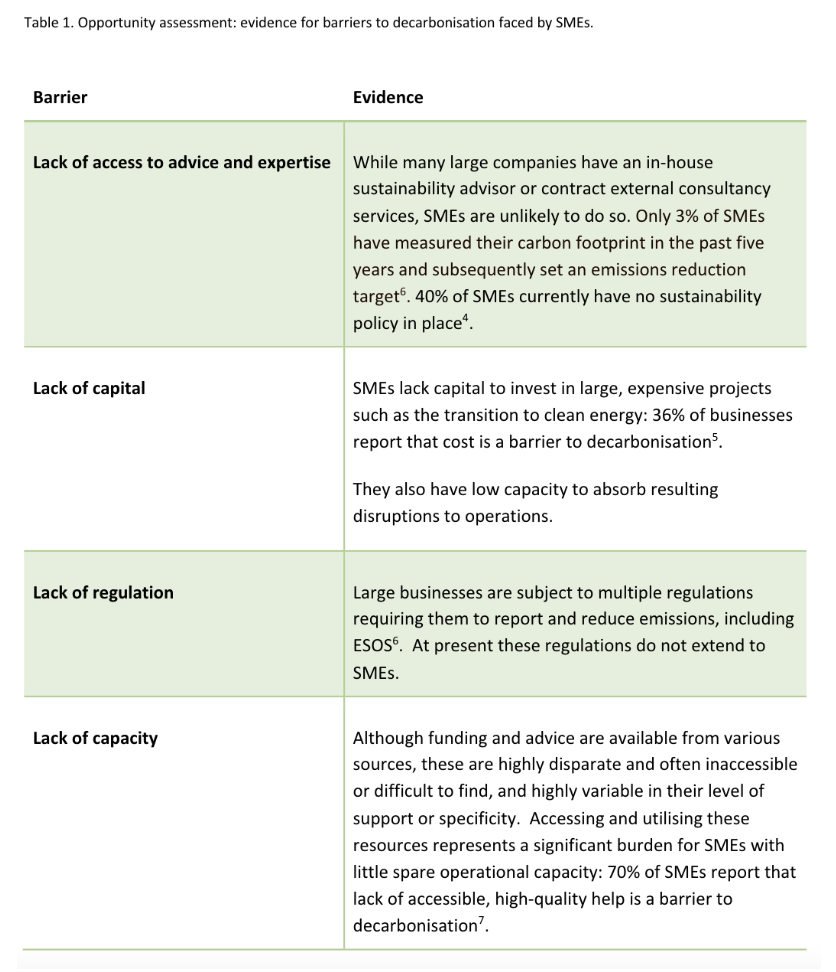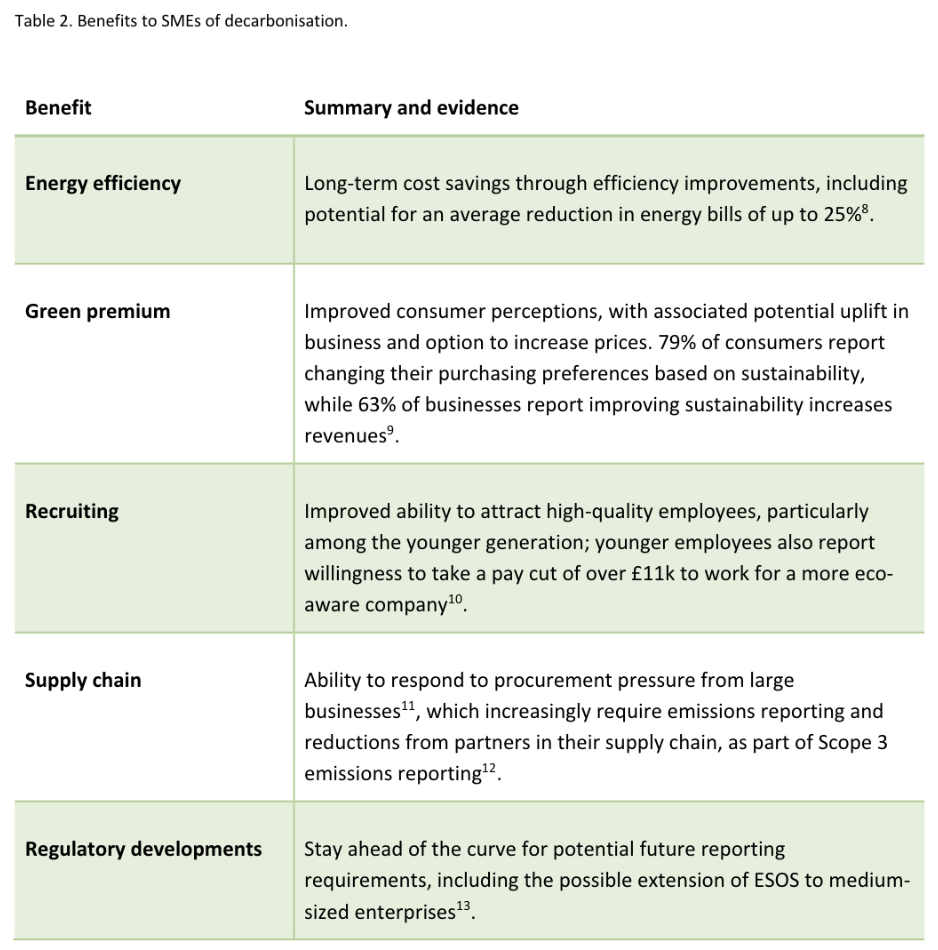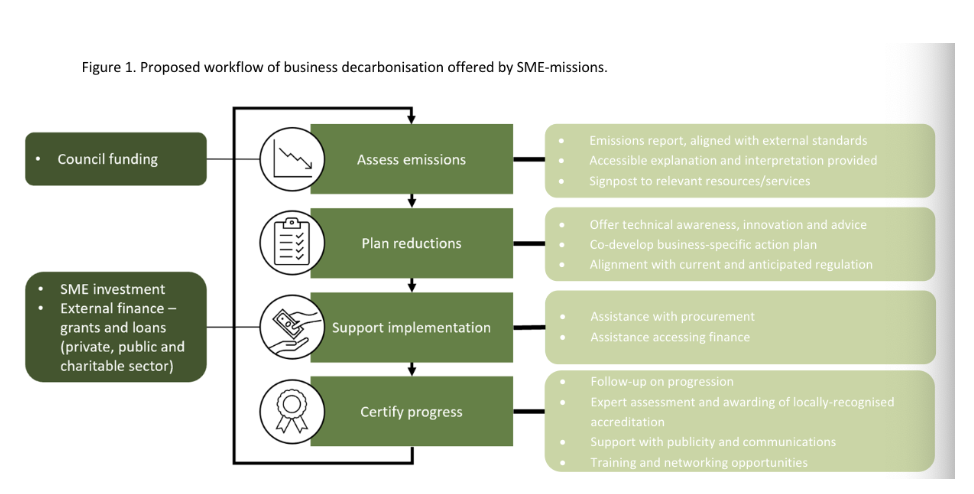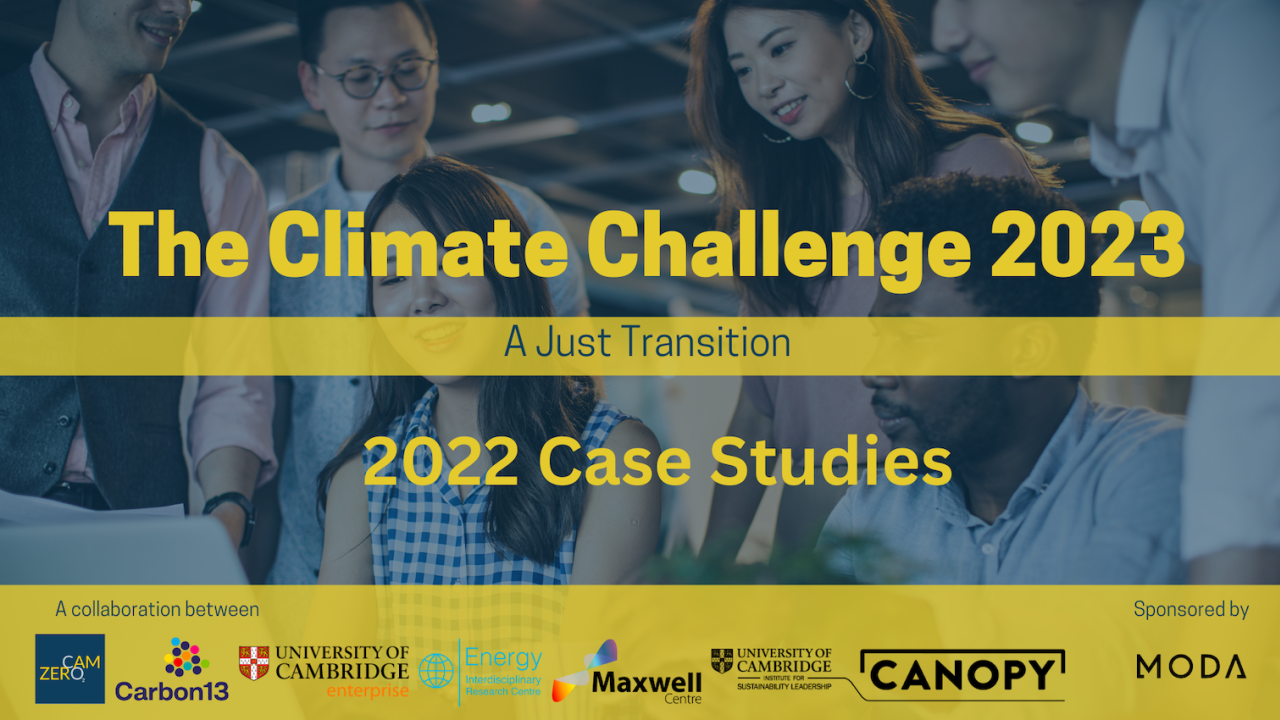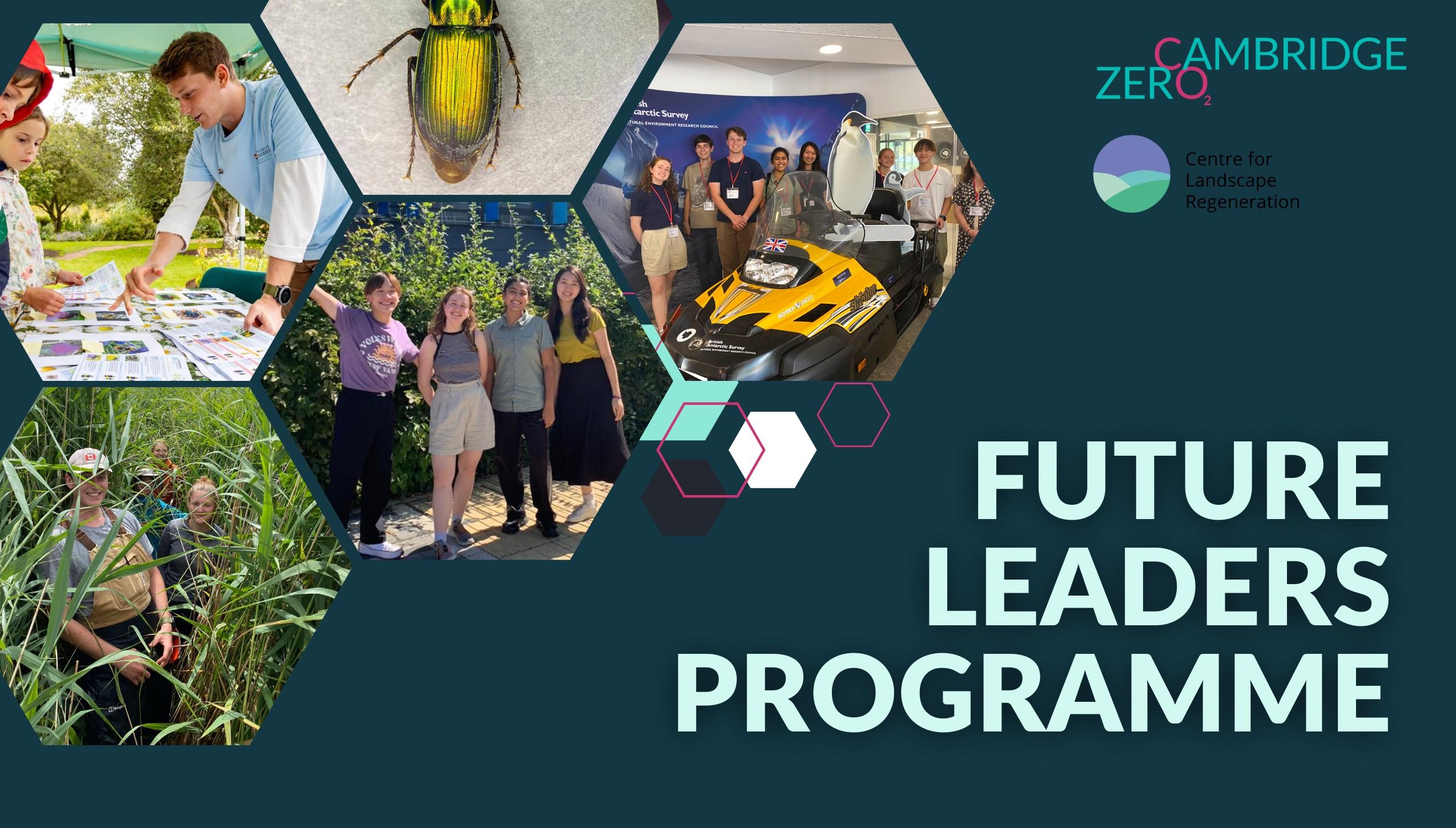Climate Challenge – Case Studies
In respond to requests from students on the Climate Challenge 2023 programme, we are collating a few case studies from previous iterations of the competition (previously named ‘Carbon Challenge’).
These are the initiative summaries taken from the concept notes submitted for shortlisted entries to the Carbon Challenge 2022, where the theme was ‘Daily Decarbonisation’. We hope these will serve as inspiration as you start to think about developing your concept notes in teams.
CarbonLESS Construction – Runner Up
Repurposing waste construction materials is a leading solution in addressing carbon emissions stemming from the construction sector. While there are several solutions that address this issue, there are few streamlined programs that provide these services in sub-Saharan African nations. CarbonLESS Construction aims to build a marketplace for construction waste in SSA that incorporates existing informal upcyclers/ recyclers into its supply chain. This will provide buyers with quality assured, consistent products, and sellers and informal markets with consistent prices and access to demand.
We wanted to strike a balance between delivering a carbon mitigating solution that is tried and tested with the scope to address a significant part of the carbon equation and delivering a solution in an innovative way in an un(der)tapped market. Our inspiration came from our shared, yet varied experiences in the construction and manufacturing industries. We wanted to explore how carbon can be reduced not just in production but also consumption cycles and how an interdisciplinary approach can enhance coordination between the two ends of the spectrum.
CO2UNTER - Shortlisted
Our carbon footprint is not something most consider on a daily basis. There is a push in some areas to increase awareness of our impact on the planet through the choices we make; what food we buy, or how we travel to work. But, in a world that is increasingly digital, we feel that not enough is being done to lay infrastructure for the carbon neutrality of technology in the coming silicone age. Ultimately, we want to ensure that advancements in technology run in parallel with advancements in sustainability.
Our product reduces carbon emissions generated by technological usage in business and domestic computers. From sending an email (around 4g of CO2 emissions) to streaming an hour long video (equivalent to powering a lightbulb for 15 days), electronic usage rapidly accumulates unknowingly. We hope to promote change through implementing a computer program that calculates, monitors, and makes suggestions on how to reduce the carbon footprint of digital interactions. For instance, before sending an email, the program would pop up and suggest that ‘Your email is currently contributing 50g of carbon to your footprint. If you send your attachment as a link, your email will only contribute 4g.’ Furthermore, the ability to track carbon output will allow businesses aiming for net zero to gain a more accurate understanding of external factors that contribute to their footprint, thereby encouraging a carbon-efficient change to workplace practises.
IFootprint – Runner Up
Mortureux and King, both conscious of the Environmental, Social and Governance (ESG) Agenda wanted to calculate their digital carbon footprints (DCFs) to help monitor and reduce their impact. However, the lack of accessible information meant accurate predictions were not possible and therefore, iFootprint was created.
Centred around ‘how we use power’, iFootprint aims to help people take control of their DCF.
Download iFootprint on your smartphone to manage your DCF. Link your devices by pairing them to the application and monitor their individual and cumulative impact. Each device has a manufacturing and distribution carbon impact, and the personal use of applications and features has three key components: power consumption, network infrastructure and data centre electricity usage. iFootprint provides the ability to monitor your impact breakdown, improve your DCF through education, rank your monthly DCF percentage change and incentivises improving your DCF using a rewards scheme.
Our aim: small individual changes that together make a positive global impact.
Incubate the CO2 Electroreduction Technique to Address the Carbon Challenge - Shortlisted
The modern industry has been founded on burning fossil fuels, which are cheap and abundant, to satisfy the high level of energy consumption. Fossil fuels, however, are unrenewable and would inevitably emit tremendous amounts of CO2, the main contributor of greenhouse effect. The emission from human activities has altered the Earth’s atmosphere tremendously, increasing the global mean temperature by about 1oC higher than that in the late 19th century. In 2016, the Paris Agreement set the long-term goal to limit global warming to well below 2, preferably 1.5 oC, compared to pre-industrial levels. In line with the goal, carbon markets, both compliance and voluntary one, have grown rapidly where national, regional and international regimes trade and regulate carbon allowances to reduce overall carbon emissions. The recent COP26 (2021) firmly stated that all of us should work together to secure the global net zero by mid-century (2050) and keep the 1.5 oC within reach. Intuitively, we have to constrain the carbon emission in the future and to address the current high level of greenhouse gas in the atmosphere. Multiple solutions across various sectors have been put on the stage to approach the goal and alleviate global warming. And each individual innovation is integral to reach the 2050 net-zero emission.
In our proposal, we would like to utilise the advanced CO2 electroreduction which can directly reduce the excessive CO2 emission and produce useful by-products of syngas (the mixture of CO and H2, a replacement of natural gas, and an important raw material for chemicals production). This conversion is achieved by the catalysts consisting of non-noble elements Zn, Co, N, C and thus significantly decrease the cost. The total current density reamins to be over 25mA/cm2 and the Faradaic efficiency of syngas remains to be over 90% during the 30 hours stability test. The above results indicate that the CO2 reduction rate can reach 20.5 mg/h, the syngas (if CO : H2 = 3:1) generation rate can reach 13.7 mg/h with the electrode area of only 1cm2. The related research project has been published (W. Zhu, et al. Angew. Chem. Int. Ed. 2020, 59, 31) and been patented (110465290A). If the electrode area were enlarged to 1m2, it’s promising that the CO2 reduction rate and the syngas generation rate can be increased to 10,000 times, indicating that the CO2 reduction can reach over 1.79 t/year and the syngas generation rate can reach over 1.21 t/year per electrode of 1m2. In this way, it’s a promising and powerful way to release the CO2 over-emitting and to generate sustainable energy at an industrial level.
No train no gain: taking the carbon emissions out of conferences - Shortlisted
We began recording our work-related CO2 emissions in 2017. This has made one point extremely clear: by far the biggest contributor to our emissions is flying. Colleagues, friends and research all suggest we’re not alone in this. Furthermore, flying is one of the worst ways to emit greenhouse gases, as they remain in the upper atmosphere much longer.
As most in academia, business or industry know, we’re flying for conferences and events. They’re fantastic fun and hugely important to build networks. While COVID-19 has shown that virtual conferences can work, this won’t solve everything. For most intracontinental conferences there is a simple method to reduce CO2 emissions: train travel. CO2 emissions from trains are around 10% of that from planes (for the same distance travelled). So why isn’t everyone travelling by train? We believe there are two key reasons: cost and complexity. We propose a simple and scalable business to make train travel the default option for short-distance conferences.
Making it affordable
Consider (as one of our team members recently had to) travelling from Cambridge to Lausanne for a conference on solar panels. Six months before the conference, door-to-door return travel costs around £190 for both train and plane. However, two weeks before the conference the journey costs £210 by plane and £360 by train. Figure 1 shows more examples of trains being cost competitive when booked months in advance, alongside comparative CO2 emissions and travelling time. Importantly, journey times are often comparably once travel to and from the airport is factored in.
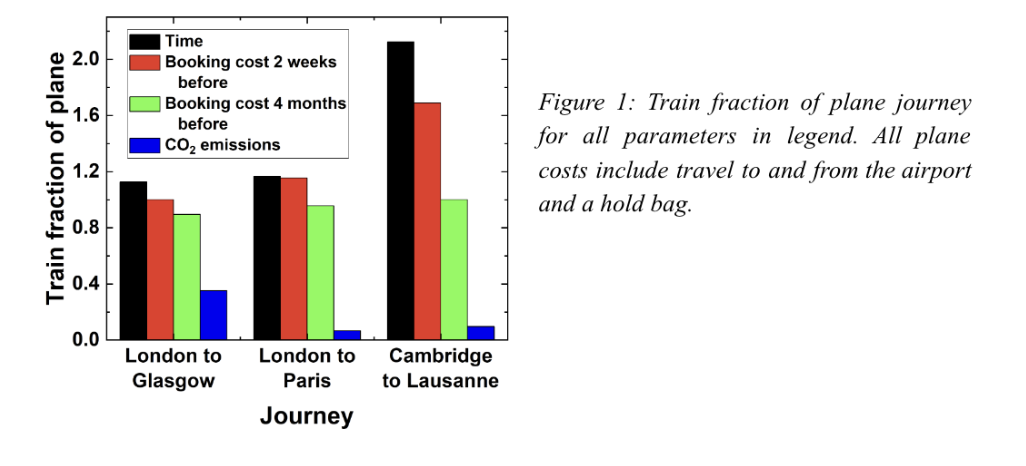
Booking six months in advance is not viable for individuals and businesses due to uncertainty in whether they will attend a conference. However, the conference will have a well-defined number of attendees with identifiable points of origin. Our company will work with conference organisers to establish these points of origin. For example, if 100 people from Cambridge submit an application to present at a conference in Lausanne, we will purchase 50 train tickets from Cambridge to Lausanne at the low prices available four months away. Furthermore, we aim to negotiate reduced rated by bulk purchases. By working directly with conference organisers, emails confirming who is accepted to attend the conference will include our low-cost train tickets. In short, we will enable attendees to buy low cost train tickets close to the event, when they can safely commit to arranging travel. We will highlight equivalent flying costs and associated CO2 footprints in our message.
Making it simple
Flying from Cambridge to Lausanne requires two short-distance train tickets and one plane ticket. Travelling by train only requires four train tickets and knowledge of how to travel through Paris. We will share our knnow-how at the point of sale, making the journey much more manageable.
Our company will revolutionise intracontinental conference travel, enabling people to travel comfortably, cheaply and with a low carbon footprint. We summarise our proposal in Figure 2.
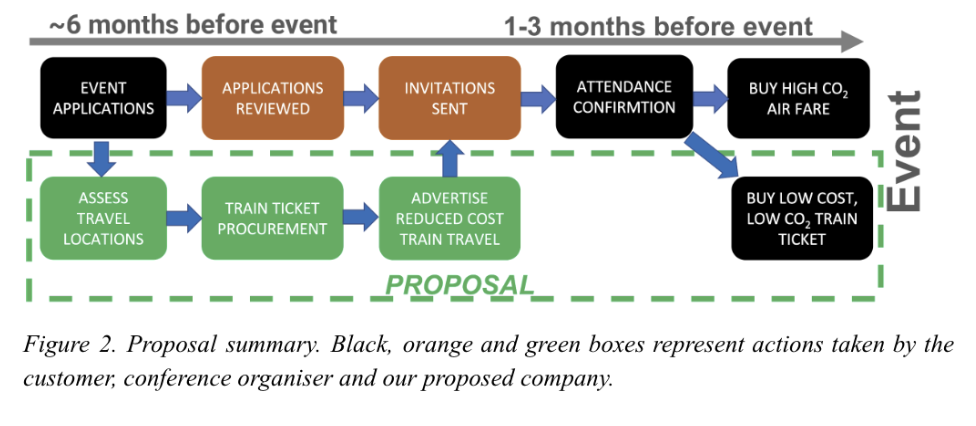
PeatGen AI - Winner
Degraded peatland makes up a tiny proportion of the global landmass on earth – just 0.3% - but contributes disproportionately to carbon emissions, releasing approximately 1.9 gigatonnes of carbon dioxide equivalent every year, or around 5% of annual anthropogenic emissions. In addition, if managed properly, peatland is one of only a few select landcover types that can even act as a carbon sink. With the price of carbon set to increase as we approach 2050, we therefore see an opportunity for landowners to be rewarded for altering their land management practices through the introduction of financial incentives such as carbon credits.
Current peatland assessment methods rely on point estimates, collected through in-person field measurements. As such, we believe there is an opportunity for technology to be applied to this under-researched but high potential space. By harnessing the power of artificial intelligence, combined with state-of-the-art data harvesting resources – such as drones mounted with ground-penetrating radar and use of satellite imagery – we believe technology can assess regeneration projects of degraded peatland at a larger scale, with higher accuracy and ultimately at a lower cost than current best practice.
Renewable Hydrophonics Farms - Shortlisted
Inspiration/challenge
Having lived in both rural and urban settings, we have noticed significant variance in the quality of vegetarian food and a dominance of imported products compared to locally sourced ones across several countries. Large-scale farming aims at continuously reducing costs and yield losses, resulting in a large proportion of international exports and extensive pesticide use1. These effects have a major impact on the environment due to deforestation, packaging and transportation requirements, without necessarily increasing nutritional value. Agriculture is currently estimated to contribute about 10% of global carbon emissions2. Vertical farming and hydroponics are revolutionising the way we produce and consume food, utilising the most cost-and space-efficient technology for indoor crop production. Transition to high-precision, high-efficiency farming is inevitable and necessary if we are to tackle climate change, just like the transition to renewable energy and circular economies. However, vertical farming facilities have high electricity requirements which, if uncontrolled, offset a lot of their cost and sustainability advantages.
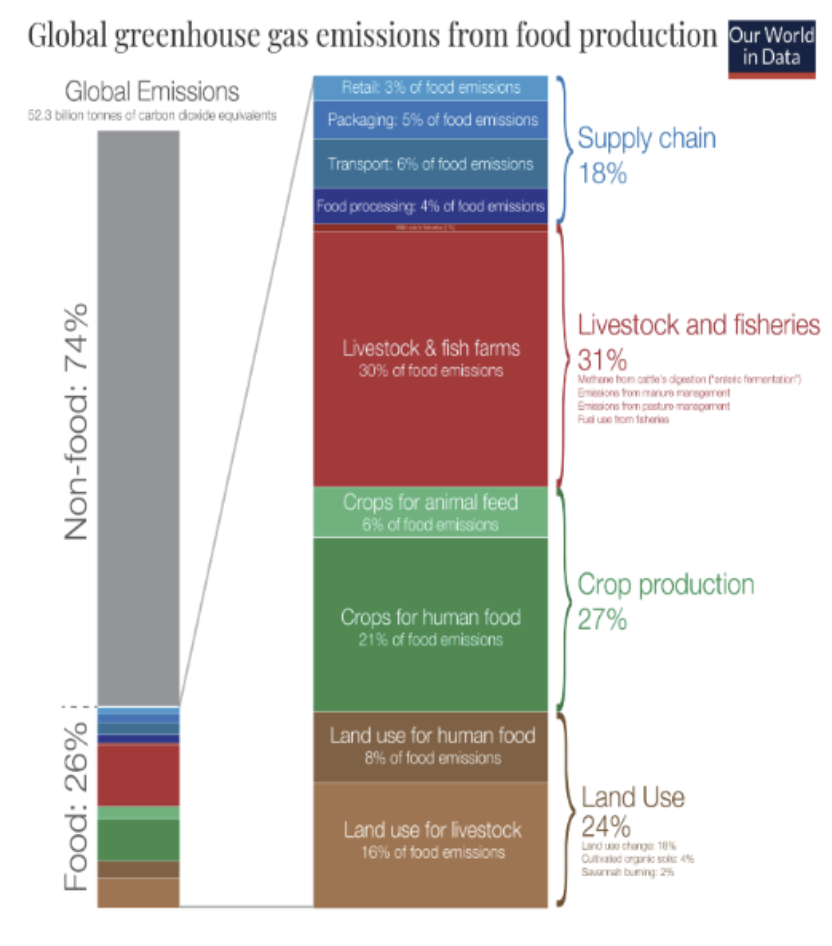
Proposed solution
Our vision is to combine existing renewable energy generation and storage technologies with a proven vertical farming concept to create universally deployable and scalable Renewable Hydroponics Farms (RHFs).
RHFs are indoor controlled environments and thus largely independent of location and local climate. Utilising closed circuits, RHFs consume significantly less water (90-95% reduction) and produce marginal waste compared to traditional agriculture, while not requiring pesticides to guarantee a profitable yield. This increases production resilience in any environment, minimising transportation costs and operational footprint. RHFs also don’t affect soil composition and fertility and allow large areas of farmland for reforestation to increase biodiversity and ultimately ‘re-wild nature’3.
Combining these benefits with renewable energy generation, RHFs are less carbon intensive than any other agriculture practice. Depending on the local environment combination of different technologies such as solar panels, wind, or hydro can be utilised, along with storage assets to regulate electricity frequency and surges.
SME-Missions – Runner Up and Audience Choice
Within the commercial sector, small-and medium-sized enterprises (SMEs) currently lag behind large businesses in the process of assessing and reducing carbon emissions. Although per-business emissions from SMEs tend to be low, as a sector SMEs account for around half of total emissions from business in the UK1. Reducing emissions from SMEs therefore represents a key stepping-stone to reaching net zero. SMEs face unique barriers to decarbonisation not posed to larger enterprises, due mainly to financial and capacity-based constraints (Table 1). As a result, 76% have not yet implemented comprehensive decarbonisation strategies and just 3% have measured their carbon footprint in the last five years and set an emissions reduction target2. However, relative to other sectors these barriers to decarbonisation are relatively simple to overcome through enlisting external resources –offering the tantalising prospect of accelerated decarbonisation at low cost. Existing attempts to bridge these barriers, in the form of grants, loans, advice and toolkits, are highly disparate and often difficult to find, with extensive variation in their accessibility, specificity and level of support. For many SMEs looking to decarbonise, accessing these services is too great a burden, despite clear direct benefits and returns on investment (Table 2). We believe a key gap exists around the provision of an integrated and cohesive SME-specific decarbonisation service, taking small enterprises from initial emissions assessments, through planning and implementation of decarbonisation measures, to review and certification of emissions reductions (Figure 1). SME-missions fills this gap by offering a comprehensive service that will help SMEs to navigate the complex sustainability space and reduce their emissions effectively, efficiently and with minimal burden on the enterprise.
Last year, we worked closely with Cambridgeshire County Council to produce a report on decarbonisation opportunities, as part of a CUSPE Policy Challenge. Among our recommendations was the establishment of a SME-specific carbon advisory service for Cambridgeshire, similar to the BEE Anglia scheme which operates in Suffolk and Norfolk3. This proposal received unanimous support from the Council’s Environment Committee. However, it was apparent that the Council lacked the capacity to provide such a service in-house. Therefore, we see a clear opportunity for a third-party organisation to implement a scalable model that can be rolled out to councils across the UK, enabling efficient and rapid decarbonisation.
